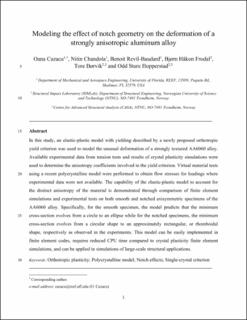| dc.contributor.author | Cazacu, Oana | |
| dc.contributor.author | Chandola, Nitin | |
| dc.contributor.author | Revil-Baudard, Benoit | |
| dc.contributor.author | Frodal, Bjørn Håkon | |
| dc.contributor.author | Børvik, Tore | |
| dc.contributor.author | Hopperstad, Odd Sture | |
| dc.date.accessioned | 2021-03-17T08:47:13Z | |
| dc.date.available | 2021-03-17T08:47:13Z | |
| dc.date.created | 2020-09-16T12:32:27Z | |
| dc.date.issued | 2020 | |
| dc.identifier.citation | European Journal of Mechanics. A, Solids. 2020, 82, . | en_US |
| dc.identifier.issn | 0997-7538 | |
| dc.identifier.uri | https://hdl.handle.net/11250/2733809 | |
| dc.description.abstract | In this study, an elastic-plastic model with yielding described by a newly proposed orthotropic yield criterion was used to model the unusual deformation of a strongly textured AA6060 alloy. Available experimental data from tension tests and results of crystal plasticity simulations were used to determine the anisotropy coefficients involved in the yield criterion. Virtual material tests using a recent polycrystalline model were performed to obtain flow stresses for loadings where experimental data were not available. The capability of the elastic-plastic model to account for the distinct anisotropy of the material is demonstrated through comparison of finite element simulations and experimental tests on both smooth and notched axisymmetric specimens of the AA6060 alloy. Specifically, for the smooth specimen, the model predicts that the minimum cross-section evolves from a circle to an ellipse while for the notched specimens, the minimum cross-section evolves from a circular shape to an approximately rectangular, or rhomboidal shape, respectively as observed in the experiments. This model can be easily implemented in finite element codes, requires reduced CPU time compared to crystal plasticity finite element simulations, and can be applied in simulations of large-scale structural applications. | en_US |
| dc.language.iso | eng | en_US |
| dc.publisher | Elsevier | en_US |
| dc.rights | Attribution-NonCommercial-NoDerivatives 4.0 Internasjonal | * |
| dc.rights.uri | http://creativecommons.org/licenses/by-nc-nd/4.0/deed.no | * |
| dc.title | Modeling the effect of notch geometry on the deformation of a strongly anisotropic aluminum alloy | en_US |
| dc.type | Peer reviewed | en_US |
| dc.type | Journal article | en_US |
| dc.description.version | acceptedVersion | en_US |
| dc.source.pagenumber | 14 | en_US |
| dc.source.volume | 82 | en_US |
| dc.source.journal | European Journal of Mechanics. A, Solids | en_US |
| dc.identifier.doi | 10.1016/j.euromechsol.2020.104004 | |
| dc.identifier.cristin | 1830412 | |
| dc.relation.project | Norges forskningsråd: 250553 | en_US |
| dc.description.localcode | © 2020. This is the authors’ accepted and refereed manuscript to the article. Locked until 30 March 2022 due to copyright restrictions. This manuscript version is made available under the CC-BY-NC-ND 4.0 license http://creativecommons.org/licenses/by-nc-nd/4.0/ | en_US |
| cristin.ispublished | true | |
| cristin.fulltext | postprint | |
| cristin.qualitycode | 1 | |

